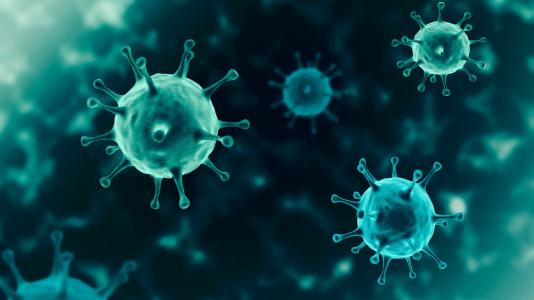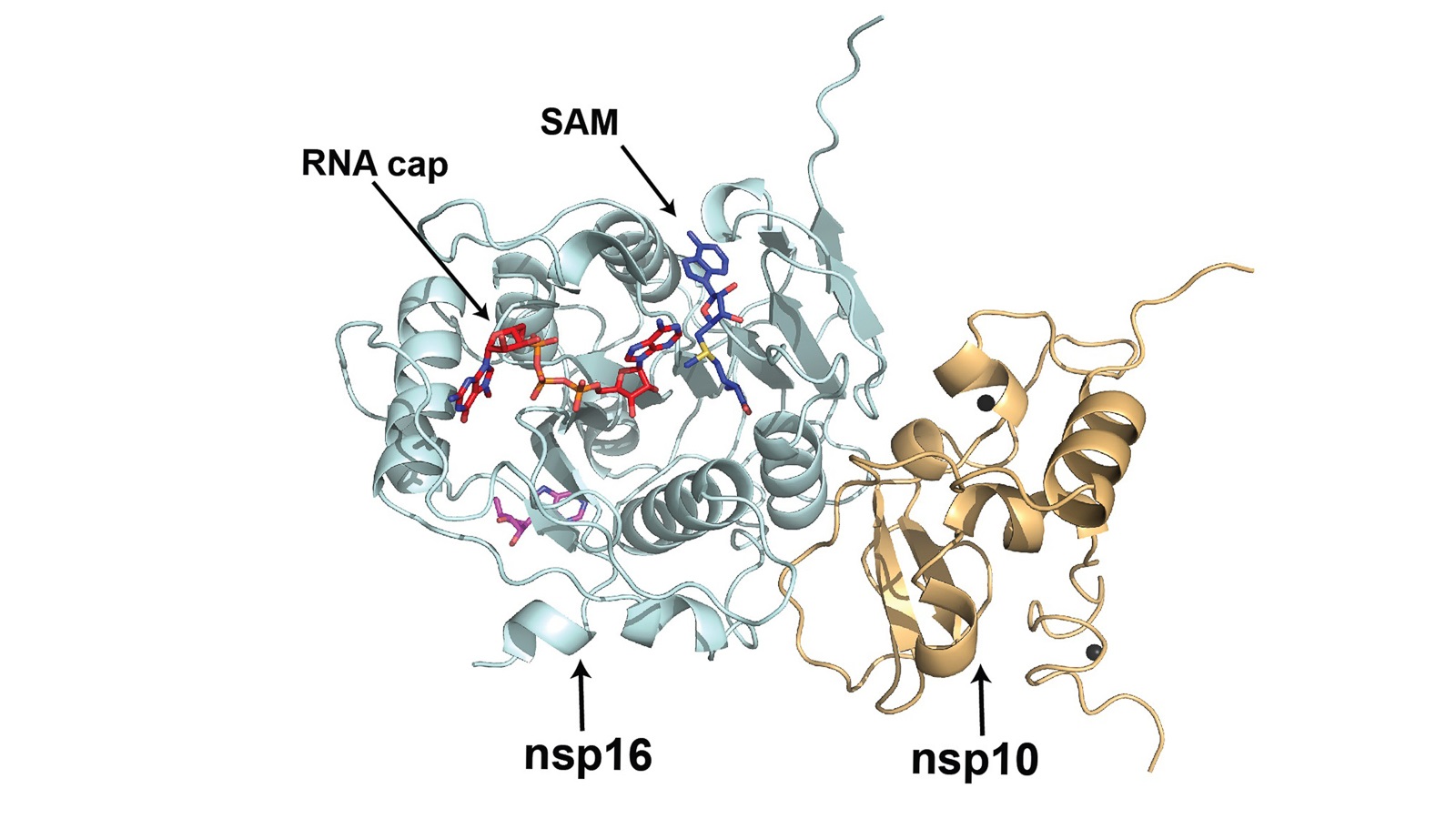Hide and seek: Understanding how COVID-19 evades detection in a human cell

Scientists around the world have been working for months to identity and develop treatments that combat SARS-CoV-2, the virus that causes COVID-19. An important part of that process is understanding how the virus evades detection inside the human body, camouflaging itself to hide from the body’s immune system.
A team of researchers using the Advanced Photon Source (APS), a U.S. Department of Energy (DOE) Office of Science User Facility at the DOE’s Argonne National Laboratory, has revealed insights into the mechanism the virus uses to elude the immune system. This pivotal discovery was published in Nature Communications.
“The virus uses the classical mechanism of camouflaging and exploiting the host machinery for its own protein synthesis. It goes inside the host cell and its messenger RNA looks the same as the host messenger RNA.” — Yogesh Gupta, assistant professor, University of Texas Health Center at San Antonio
“A lot of researchers are looking at how the virus enters a cell,” said Yogesh Gupta, assistant professor at the University of Texas Health Science Center at San Antonio and corresponding author on the paper. “We wanted to look at what happens when it is inside the cell. How does the virus survive and evade immune mechanisms?”
To do this, Gupta and his team examined two of the SARS-CoV-2 proteins, known as nonstructural proteins 10 and 16, using the ultrabright X-rays generated by the APS. The work was performed at the Northeastern Collaborative Access Team (NE-CAT) beamline, number 24-ID, which is managed by Cornell University.
They discovered that the SARS-CoV-2 virus uses some unique ways to camouflage its messenger ribonucleic acid (RNA), the single-stranded molecule that carries the genetic code for synthesizing proteins, to mimic those of the host cell. The immune system cannot differentiate it from the body’s own messenger RNA, so it doesn’t fight the virus off.
It is a little like wearing a blue-collared shirt to Best Buy. You may not work there, but people will treat you like you do, in the same way that a host cell’s immune system will treat the virus like it belongs.
“The virus uses the classical mechanism of camouflaging and exploiting the host machinery for its own protein synthesis,” he said. “It goes inside the host cell and its messenger RNA looks the same as the host messenger RNA.”
Gupta said this process was thought to be similar to those seen in previous coronaviruses, but his team observed some unique features in the SARS-CoV-2 protein. Understanding how this particular virus uses this protein to avoid detection will help with designing new treatments. What’s needed, he said, is a drug that targets the virus, not the host, and knowing more about the camouflage mechanism will help develop one.
The research team also discovered a unique pocket in the structure of the proteins, one that is not present in previous coronaviruses. This pocket, Gupta said, may be a strong target for antiviral development.
NE-CAT is one of 16 beamlines at the APS that have dedicated a significant portion of beam time to COVID-19 research, using a technique called macromolecular crystallography. This involves diffracting X-ray beams off of crystals grown from synthetic proteins — APS scientists do not work with the live virus — to precisely determine their structures, often in complex with drug candidates or other chemicals.
The research team accessed the NE-CAT beamline remotely, operating it through a computer interface. Remote and mail-in experiments have been the focus of the APS since March, as a result of the COVID-19 pandemic. But scientists using NE-CAT are likely used to the interface, since 95 percent of the beamline’s research is carried out remotely, according to Frank Murphy, associate director of NE-CAT and a senior research associate at Cornell.
“The APS is a great place to do photon science,” Murphy said, “and it’s the best place in the world to do macromolecular crystallography. We have so many good people and good beamlines.”
Gupta’s team has been using the APS since 2007, employing various X-ray techniques to uncover insights into biological structures.
“The APS is a unique facility that allows us to measure X-ray diffraction data precisely and quickly,” he said. “We are fortunate to have a relationship with the APS, and it has allowed us to further our knowledge of the basic mechanisms of this virus.”
The Advanced Photon Source is a U.S. Department of Energy (DOE) Office of Science User Facility operated for the DOE Office of Science by Argonne National Laboratory. Additional funding for beamlines used for COVID-19 research at the APS is provided by the National Institutes of Health (NIH) and by DOE Office of Science Biological and Environmental Research. The APS operated for 10 percent more hours this year than usual to support COVID-19 research, with the additional time supported by the DOE Office of Science through the National Virtual Biotechnology Laboratory, with funding provided by the Coronavirus CARES Act.
About the Advanced Photon Source
The U. S. Department of Energy Office of Science’s Advanced Photon Source (APS) at Argonne National Laboratory is one of the world’s most productive X-ray light source facilities. The APS provides high-brightness X-ray beams to a diverse community of researchers in materials science, chemistry, condensed matter physics, the life and environmental sciences, and applied research. These X-rays are ideally suited for explorations of materials and biological structures; elemental distribution; chemical, magnetic, electronic states; and a wide range of technologically important engineering systems from batteries to fuel injector sprays, all of which are the foundations of our nation’s economic, technological, and physical well-being. Each year, more than 5,000 researchers use the APS to produce over 2,000 publications detailing impactful discoveries, and solve more vital biological protein structures than users of any other X-ray light source research facility. APS scientists and engineers innovate technology that is at the heart of advancing accelerator and light-source operations. This includes the insertion devices that produce extreme-brightness X-rays prized by researchers, lenses that focus the X-rays down to a few nanometers, instrumentation that maximizes the way the X-rays interact with samples being studied, and software that gathers and manages the massive quantity of data resulting from discovery research at the APS.
This research used resources of the Advanced Photon Source, a U.S. DOE Office of Science User Facility operated for the DOE Office of Science by Argonne National Laboratory under Contract No. DE-AC02-06CH11357.
Argonne National Laboratory seeks solutions to pressing national problems in science and technology. The nation’s first national laboratory, Argonne conducts leading-edge basic and applied scientific research in virtually every scientific discipline. Argonne researchers work closely with researchers from hundreds of companies, universities, and federal, state and municipal agencies to help them solve their specific problems, advance America’s scientific leadership and prepare the nation for a better future. With employees from more than 60 nations, Argonne is managed by UChicago Argonne, LLC for the U.S. Department of Energy’s Office of Science.
The U.S. Department of Energy’s Office of Science is the single largest supporter of basic research in the physical sciences in the United States and is working to address some of the most pressing challenges of our time. For more information, visit https://energy.gov/science.
